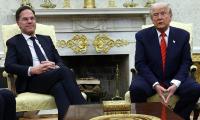Political commentators have long held that the Doha peace deal will not be able to survive the change of leadership in the White House following the November elections in the US. This opinion was driven more by the prevailing dynamics that inform America’s ‘forever’ war in Afghanistan and less by any fundamental difference on the deal's design.
President Biden’s announcement of the complete troop exit from Afghanistan on September 1, days ahead of the 20th anniversary of the 9/11 attacks, may have caught some stakeholders unawares including America’s Nato allies. But it has, at least, provided a strategic clarity to a mission whose fate hangs in the balance due to several factors, the chief being the inability of the Taliban and the Kabul government to produce a unanimous power-sharing formula.
It has been stated that the Taliban’s refusal to attend the Istanbul peace huddle forced the Biden Administration to announce its ‘alternative’ withdrawal plan that was in the works as part of the review process of the Doha deal. The fact is that banking on the deal to produce an outcome that suits all parties to the Afghan conflict flew in the face of peculiar realities in Afghanistan.
The Doha deal, no doubt, represented the Trump administration’s effort to bring some kind of order to a country that is historically known for never-ending strife. The specifics of the deal required that all stakeholders privilege the interests of the Afghan people over their own and work in unison to achieve a modicum of political stability for the war-torn country.
As the subsequent developments following the conclusion of the Doha peace agreement in February 2020 indicated, the Taliban and the Ashraf Ghani-led government, two principal actors, worked at cross purposes. Kabul objected to Washington’s approach to directly deal with the Taliban, an approach that the government said undermined its authority and gave the Taliban a semblance of legitimacy.
On the other hand, the Taliban took the peace process as an opportunity to increase the stakes as the likely inheritor of power once the coalition forces left Afghanistan. The conditions on the ground whereby the Taliban held the initiative supported such an assertion.
However, the conditionalities prescribed as part of the Doha agreement were meant to temper the Taliban’s wild power ambitions in an effort to make the transition a little orderly and give the whole political exercise an appearance of a negotiated settlement.
Biden’s announcement has put paid to such efforts and revived the prospect of intense violence breaking out in the event of the US military withdrawal post-September. It has freed the Taliban and other factions of any commitment to the Doha peace deal, thus rendering the field wide open for the powerful to take over on the basis of their fighting prowess.
The White House decision has pushed all the actors with stakes in Afghanistan back to their drawing rooms. Before them is the onerous task to review the emergent situation and come up with the ‘best workable’ options. In addition to sparking a fresh round of anxiety, the development has also renewed the possibility of Afghanistan becoming a new theatre of a cold war between the rival countries.
Some political analysts state that Biden’s decision to cut and run is aligned with his administration’s principal priorities shaped by domestic considerations, particularly the formidable challenge of fighting Covid-19 and repairing the US from inside. They point to the fact that any extended American military presence in Afghanistan is unlikely to achieve anything substantial. The threat of terrorism has been considerably downgraded and a combination of factors such as bad governance and corruption that are said to be endemic in Kabul serves to disincentivize any long-term commitment. The Taliban continue to remain resilient with even greater stakes than before.
More than anything, the Biden Administration’s new policy ends the practice of looking at overseas military ventures in isolation from the pressing issues of domestic nature and recognizes the new and more formidable threats such as China, Russia, Iran, and the Middle East.
Responding to the charge of the withdrawal plan being abrupt and sudden, analysts hold that various US administrations have seriously considered the idea of drawing down at different times. As late as 2014, President Obama mulled reducing the military presence from active combat missions to training the Afghan National Security Force.
No matter how ‘convincing’ the arguments justifying the abrupt withdrawal look like, the fact is that America’s longest-running war in history is coming to an end with ignominy for the sole superpower of the world. The winding-up of the war effort with ambiguous victory claims and without putting in place the post-withdrawal political arrangement is an admission of failure on so many counts.
From the grandiose ‘nation-building’ missions of establishing democracy, liberating women, and building ‘representative’ institutions, the American goalposts have been changing in Afghanistan. After an experience of two decades of the deadly war that saw about 2500 US troops killed, over $2 trillion lost, and the hundreds of thousands of innocent Afghans and Pakistanis killed, the US is confronted with the irony that it is easy to start a war but difficult to end it despite presiding over the best war machine.
President Biden’s reiteration to keep working with the Afghan government and involve regional players such as Pakistan, China, and Russia, etc notwithstanding, his administration’s pullout plan seems to take a leaf from its book of the 1990s when it hastened to leave the war-torn country with horrible consequences.
History appears to be repeating itself this time as well. The consequences that flowed from the events of the ill-thought-out departure do not seem to have weighed in on the present decision.
While the ability of Al-Qaeda to launch a terrorist act of a reasonable magnitude may have been downgraded, the presence of the dreaded IS in various forms and shapes in different parts of the world means that countries ignore the threats of potential violence at their own peril. The possibility of transnational terror outfits such as IS becoming more powerful remains real. And Afghanistan provides a fertile ground for such terrorist groups.
The continuing civil war in Afghanistan after the American withdrawal will multiply security and economic challenges for Pakistan. An influx of refugees will test Pakistan’s ability to cater to their material needs especially during the current economic slowdown due to Covid-19. At the same time, there are valid concerns that the remnants of the TTP that are holed up in safe havens in Afghanistan will use the conditions to stage a comeback and threaten Pakistan’s security.
Post-withdrawal Afghanistan is a tinder box ready to explode, the flames of which will envelop not just Afghanistan but also the region, a prospect that the US will regret one day.
The writer, a Chevening scholar, studied International Journalism at the University of Sussex.
Email: amanatchpk@gmail.com
Twitter: @Amanat222
People of that time believed that an eclipse was a symbol of displeasure of gods
Vertically speaking, dominance of domestic debt in Pakistan’s debt portfolio is haunting
Loss of biodiversity is stark reminder that urban mismanagement is not just infrastructural failure but ecological...
Strong public warning systems can also help ensure quick evacuations in places prone to fires
PPPs in Pakistan's WASH sector face significant regulatory and policy challenges that hinder their effectiveness
Instead, it would have powerful chairman with three-year term, appointed at prime minister’s discretion







